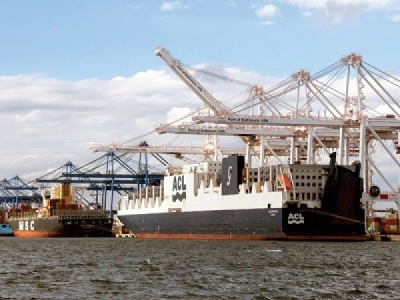
Posted on May 28, 2020
Far from the facilities in the Port of Baltimore out at the York Spit in Chesapeake Bay, crews contracted to the U.S. Army Corps of Engineers, Baltimore District are busy with maintenance dredging of the aptly named York Spit Channel. The channel is being dredged to a depth of 51 feet and is one of six channels associated with the Port of Baltimore being dredged – and in a way, this dredging is part of business as usual in this most unusual of times.
The Port of Baltimore is arguably the most diverse port on the U.S. East Coast and in 2019 had a banner year handling a record 43.6 million tons of international cargo, with containers totals up, ro-ro healthy [ninth straight year the port ranked number one in the U.S. in vehicles handled] and bulk and breakbulk figures holding their own – and going into 2020 this year looked like it might be even bigger than 2019. Then the pandemic hit.
Like every other port in the world, the COVID-19 crisis has cut into the Port of Baltimore’s numbers as blank sailing and other factors have rendered earlier optimistic forecasts outdated.
But the Port is still open, still handling cargo and still moving forward with critical projects that will position it for expansion in the post-COVID-19 world.
Richard Scher, Director of Communications for the Maryland Port Authority (MPA) wrote in answer to AJOT inquiries of the situation and the Port, “The Port of Baltimore has remained open for business for all cargo operations since the onset of the current COVID-19 pandemic. Ports America Chesapeake continues to adjust the operating hours of the Seagirt Marine Terminal. They have also closed Seagirt six times in the last two months. These changes have been due to lower international container volumes. Even when the truck gates are closed, ships are still being worked. Our other public marine terminals have continued to operate regular hours for delivery and receipt of cargo.”
Although the Port of Baltimore has seen terminal closures, the damage to cargo totals has not been as severe as might be expected during such a severe downturn. As Scher remarked, “this has been an extremely difficult time for the maritime shipping industry. The entire international supply chain has been impacted. Many ports around the U.S. are experiencing lower cargo volumes, and we [Port of Baltimore] are no different. However, our numbers so far have been better than some other ports, particularly West Coast ports. Through March, our general cargo was down 5.2%, autos were down 13.2%, and containers were down 7%. We expect to be down for the second quarter, followed by a gradual flattening in the third quarter and improvement in the fourth quarter.”
Perhaps more importantly with an eye to the future, key projects are still moving forward. Among them is the dredging to a 50-foot depth alongside at the Seagirt Terminals, which handles nearly all the Port’s box traffic. The dredging will enable the terminal to handle the mega-boxships and is part of the $32.7 million project to construct a second 50-foot deep berth at the terminal – a project that could open in a hopefully post-pandemic early 2021.
And the terminal expansion works in tandem with the long awaited and much anticipated Howard Tunnel reconfiguration. Back in March of 2019, Maryland Governor Larry Hogan’s administration submitted an application for a federal grant in March to assist with the project. The application sought $228 million from the federal government. In turn, the state would spend $147 million and CSX Corp., which owns the railroad tracks, would contribute $91 million. The importance of the tunnel project is hard to over-estimate as Scher notes, “The second, 50-foot deep berth at Seagirt and the Howard Street Tunnel projects are still moving forward. We’re very excited about both. The new deep berth will allow us to handle two supersized ships simultaneously. We’re already one of the only ports on the East Coast able to handle big ships. The tunnel is a huge game changer for us. It will get us over a long-time hurdle, the lack of double stack rail. This will grow our containers by 100,000 annually, generate thousands of new jobs, and allow us to be more competitive with our container competitors.”
While the Port of Baltimore, and indeed ports around the world, will likely see the numbers posted in 2020 lower than in recent years, the expansion programs now being put into place in Port may well lead to a more robust recovery… and perhaps some new records for the Port of Baltimore.
Source: AJOT





